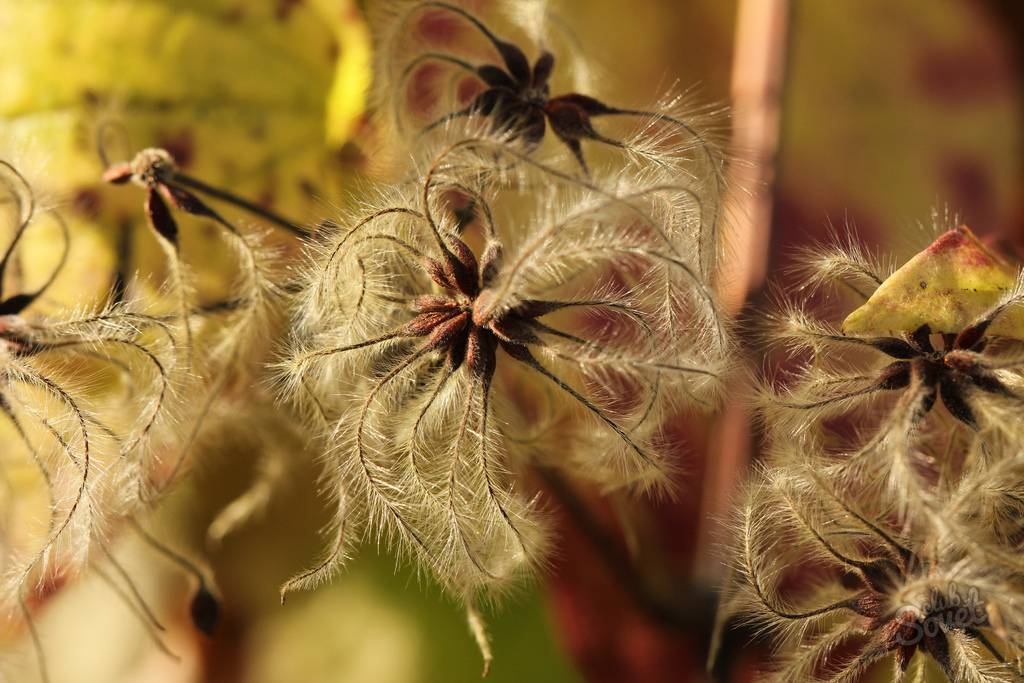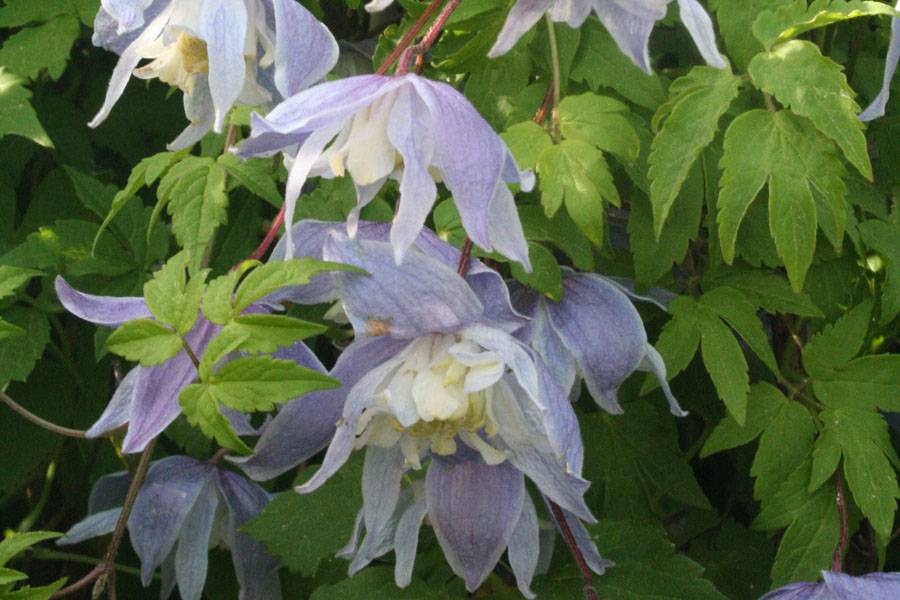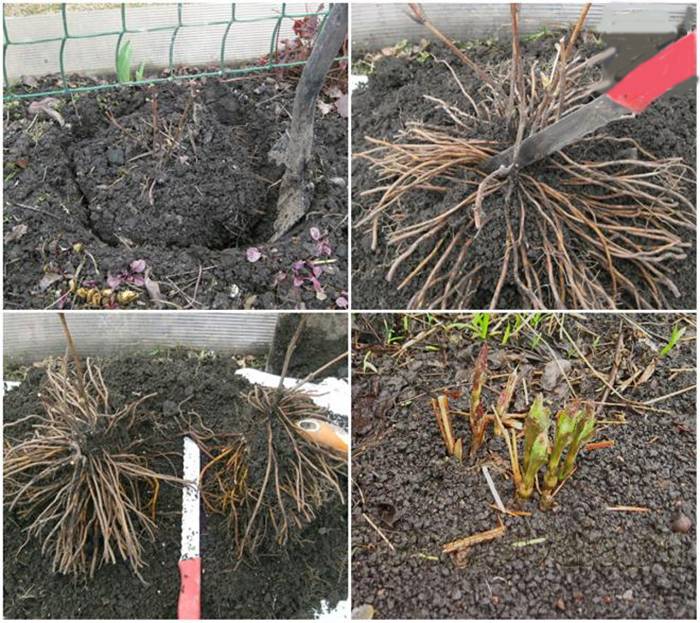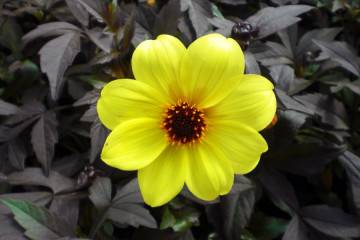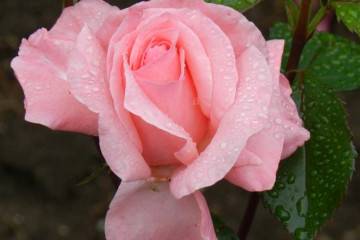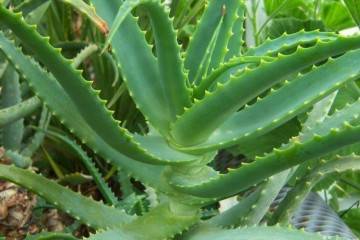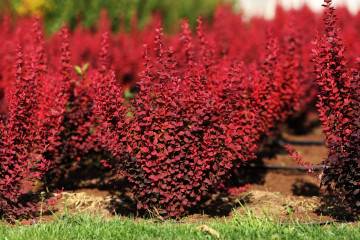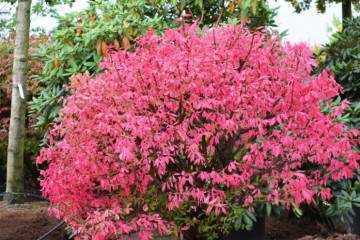All about clematis-vines - description of plant species
Content:
Clematis is rightfully considered one of the most unpretentious and beautiful vines, ideal for vertical gardening. Even one bush, covered with many spectacular star-shaped flowers, invariably attracts attention. Due to their long flowering and variety of colors, the Clematis genus is gaining more and more popularity.
What does clematis look like
In early spring, when the air warms up to +5 ° C, buds wake up on the vines and shoots start growing. In May, they are already adding up to 12 cm per day. Early clematis delight with flowering 2 months after waking up, late ones bloom at the end of summer.
Sepals play the role of petals in clematis, and the lush center often differs both in shape and color from the petals, which gives the flower a special charm. Flowers can be star-shaped or disc-shaped, have a corrugated or wavy edge. In large-flowered varieties, the flower diameter reaches 25 cm.
The color palette of clematis is varied, from pure white to blue, pink, bright red with all sorts of tone transitions. By combining them with each other and with other plants, effective color compositions are obtained.
Clematis is often called a vine for their ability to gently twine around with flexible twigs everything that comes their way, climbing up, closer to the sun. This property of plants is used, using them for landscaping walls, pergolas and arches.
Another name for clematis is clematis. It is associated with the seeds of the plant, which have a kind of curved outgrowth.
Origin
There are about 300 species, found mainly in temperate latitudes. Four centuries ago, wild clematis appeared in the gardens of Europe and in a short time became a favorite of flower growers. To this day, this plant wins the hearts of flower lovers, encouraging them to learn everything about clematis, from the history of origin to the novelties of breeding.
Clematis violet (Clematis viticella) was the first to spread. He came to England from Spain in the middle of the 16th century. Later, in the 18th century, the Swede Karl Thunberg introduced another iconic specimen into culture - flowering clematis (Clematis florida). The large-flowered clematis (Clematis patens) was brought from Japan by the German physician and naturalist Franz Siebold in 1836.
Jacqueman's first hybrid clematis was presented at the Royal Exhibition in Kensington in 1863. The amazing plant was a tremendous success, which inspired breeders to actively work on hybridization. In just 15 years, more than 200 varieties have been produced.
Many time-tested varieties still take pride of place in gardens:
- Clematis Star of India,
- Ville de Leon,
- Purpurea of captivity elegans.
Many varieties are distinguished by good frost resistance and durability.
Main groups
Numerous varieties are arranged in several groups, depending on the size of flowers, shoots and nuances of agricultural technology. Since there are many varieties and attempts to systematize have been made more than once, there is no single classification system.
System A.Raeder, based on the division according to morphological characteristics and consisting of four sections:
- Forest clematis (Clematis viorna), which includes subshrub and herbaceous species with small bell-shaped flowers.
- Clematis violet (Clematis viticella), including vines with woody and curly stems. Flowers can be simple and double, saucer or bell-shaped. This large section includes Jacquemann and Durand hybrids, woolly and purple clematis and others.
- Knyazhik (Antragene), consisting of 8 types of clematis. This includes woody lianas up to three meters long. Flowers drooping, broadly bell-shaped. Plants can withstand frosts down to -30 ° C.
- Clematis burning (Clematis flammula). Representatives of this section are not only winter-hardy, but also bloom amazingly beautifully and profusely. Despite the fact that the flowers are small, they cover the plant so densely that leaves are almost invisible under them. At the same time, they have a honey aroma.
In accordance with the size of the flower and the flowering time, clematis are divided into large-flowered and small-flowered.
Large-flowered
The varieties of the Viticella, Jacquemann, Patens, Florida and Lanuginosa groups are large-flowered climbing clematis. The Integrifolia group belongs to the climbing large-flowered ones.
Viticella Group
It is represented by shrub vines up to 3.5 m in length. The flowers are velvety, with a predominance of pink-red tones. The diameter of the flower is up to 12 cm. Flowering lasts from July until frost.
The varieties are varied. These are the lilac clematis Justa with a light purple stripe, and Polish Spirit of a rich purple color with a purple tint, and many other varieties.
Jacquemann's group
Combines varieties obtained from crossing Clematis Jackmanii with other species. This includes large shrub vines with shoots 4 m long. The color of flowers has purple, blue and purple hues. Flowering continues until the very frost.
The varieties of this group include purple-red Rouge Cardinal, ash-pink Comtes de Boucher, purple Victoria.
Patens group
It is obtained by crossing the spreading clematis (C. patens) with other varieties. There are many varieties with double flowers in this group. The color is varied: from creamy white to bright purple or deep purple. Bloom in June - July, for 30 - 40 days. Winter hardiness is low, you need to cover for the winter.
The English variety Arctic Queen strikes with large, double creamy white flowers that set off yellow anthers.
Florida
Consists of the descendants of flowering clematis (Clematis florida). These are shrubby lianas, reaching three meters in height. The color of the flowers is dominated by light tones, there are two-color varieties. They bloom in the first half of summer on the shoots of last year.
A bright representative is the Alba Plena variety with white-green sepals and green anthers. Over time, the petals fade to a completely white color, enhancing the contrast.
Lanuginose
Includes vines with thin shoots up to 2.5 m. The flowers are large, up to 20 cm in diameter, painted in delicate blue, white, pink colors. Often there is a stripe of a different color in the center of the petals.
The Ballerina variety has white flowers with a contrasting dark middle, and the Nadezhda variety has pale pink sepals and a bright red stripe in the center.
Integrifolia
It unites low (up to 1.5 m) semi-shrubs. Shoots need tying up. The flowers resemble propellers of four sepals, bell-shaped, up to 12 cm in diameter.
Bloom profusely on the shoots of the current year varieties Memory of the heart with purple flowers and pink clematis Alyonushka.
Small-flowered
Small-flowered clematis are usually unpretentious.Flowers are small, often bell-shaped, profuse flowering. These include the following groups.
Heracleifolia
Derived from crossing the hogweed clematis.
Flowers from 3 to 5 cm in diameter are predominantly white and blue. Flowering lasts from August to October. The variety New Love with dark green leaves and small blue hyacinth-shaped flowers represents this group.
Atragene (princes)
Withstands frosts down to -40 ° C. This group includes Siberian clematis. Princes bloom in the spring on overwintered shoots. The Blue Princes variety is distinguished by its two-colored double flowers, which is unusual for a prince.
Flamula
Includes white small-flowered bush clematis Burning with many small white flowers, as well as Autumn and Trizhdytroichesky clematis.
Texensis
This group originates from Texas clematis. Flowers are solitary, usually carmine-red. Koningin Maxima is remembered for its bright color and lovely tulip-shaped flower.
The wild small-flowered clematis includes paniculata and oriental clematis. These vines are especially decorative in autumn, when fluffy fruits are formed on them.
Proper care of clematis
Most clematis are perennial climbing or climbing vines that demand light. Therefore, they need reliable support.
Liana will grow well in neutral or slightly alkaline, humus-rich and well-drained soils. All varieties do not like stagnant water, as well as overdrying. Therefore, it is advisable to place a layer of sand or broken brick at the bottom of the planting pit. When planting, pay attention to the fact that the root collar should be underground at a depth of 10-15 cm.
Clematis is rarely watered, but abundantly. It is better not to use sprinklers, as drops on flowers spoil their appearance.
Throughout the growing season, the plant is fed with organic and mineral fertilizers about once every 10 days. Potash dressings are introduced in the fall.
Winter-hardy varieties easily tolerate frosts, thermophilic species need shelter for the winter. With the onset of frost, delicate varieties are removed from the support, tied and covered with agrofibre. Then they are covered with dry foliage and, in order to protect from precipitation, covered with a waterproofing material.
Pruning
Special attention is paid to pruning clematis, as this is an important condition for lush flowering. The international classification, which distinguishes three groups of clematis pruning, will help you choose the right plant and decide on the right care.
First group (A)
This includes clematis blooming on last year's shoots. They should not be shortened so as not to lose flowers. Only dried twigs are removed and too thickened specimens are thinned out. A bright representative of the group is the Atragena Franchi variety, a large liana with pale blue bell-shaped flowers.
Second group (B)
This includes hybrids that bloom twice during the season. Flowers are formed on the shoots of the current year and last year. During autumn pruning, they are shortened by half, leaving about one meter long shoots.
This group includes clematis Guernsey Cream with white flowers, its flowering is abundant, twice a season. A flamboyant representative, the red clematis Rouge Cardinal, also lives up to the group's description. Its rich red flowers re-open in the fall. The pink range of this group is represented by Clematis Little Mermaid with an extraordinary salmon shade.
Third group (C)
Includes many natural species and varieties that bloom on the shoots of the current year. For the winter, they are strongly cut off, leaving 2 - 4 lower nodes. The long-known Star of India variety belongs to this group.The flowers are purple, with a red-purple stripe, yellow anthers.
Reproduction
There are several breeding methods for clematis. Large-flowered hybrid specimens are propagated by layering, dividing the bush and green cuttings. If there is no need to preserve varietal properties, propagate by seeds.
Layers
The most effective way that does not harm the decorativeness of the plant is propagation by layering. Shoots are laid in radial grooves 5–10 cm deep. They are pressed with staples and sprinkled with soil. The top remains loose.
Layers, like the mother bush, are regularly watered and fed. The next year, the rooted plant is separated from the mother plant and transplanted to another place.
Dividing the bush
Quite an easy way. Large, overgrown plants can be divided in autumn and early growth (April – May). Before the procedure, the aerial part of the plant is cut off, leaving 2-3 pairs of buds.
The bush is dug out with a clod of earth, the roots are gently released. They divide the bush with a sharp knife so that 2-4 shoots remain on each division. The resulting cuttings must be planted in open ground.
Cuttings
The time for cuttings is determined by the condition of the shoots - they must be elastic, not brittle. Early varieties can be cut in spring, late ones in July and August.
Shoots are cut over the second or third knot from the bottom. 1-2 nodes are left on the handle itself. The leaves are shortened by half. The cut is treated with root.
Cuttings are planted obliquely. The node with the kidney is deepened by 2–3 mm, the substrate is moistened. The containers are covered with glass or foil. The optimum temperature for rooting is +25 ° C. High humidity is maintained. After about a month, the cuttings take root and they are gradually accustomed to fresh air, removing the film.
Seed propagation
The size of seeds of different species ranges from 4 to 11 mm. Stratification can be used to accelerate germination of medium to large seeds. To do this, they are mixed with sand and stored in a refrigerator at a temperature of 0-5 ° C.
Clematis is a godsend not only for an ordinary gardener, but also for a sophisticated landscape designer. They not only decorate the walls with amazing plants, but also create curbs, launching whips along a low horizontal support, and also form flowering carpets, completely depriving the liana of support.
If you run a clematis plant along an erect pine trunk, it will effectively set off the needles. By fixing clematis shoots on the branches of a shrub (barberry, rose), as well as combining with annual plants, wonderful flowering compositions are obtained. There are also dwarf container varieties that can even be grown as a houseplant (Piilu, Biju).

